
Get a quick no obligation quote It’s free and will only take a jiffy!
Holly Tree
Everything you need to know about the holly tree, from identification tips to typical characteristics; how to spot disease and the best way to maintain a holly tree.
The holly tree is of course synonymous with Christmas but some might be surprised as its ability to grow up to 15 metres in height and its longevity of some 300 years. Its prickly leaves and bright red berries are the holly tree’s key characteristics.
There are numerous varieties of holly tree, including the Silver Milkmaid, the hedgehog holly, amber holly with its notable orange berries, Alaska holly and common holly.
General Facts
| Known as | Holly, common holly, English holly |
| Latin name | Ilex aquifolium |
| Location | Europe, North Africa, South and West Asia |
| Foliage | Evergreen |
| Lifespan | 300 years |
Characteristics
| Height | Up to 15 metres |
| Spread | 4-8 metres |
| Appearance | A mid-range sized evergreen tree that grows slowly during its younger phase. The dark, glossy, prickly leaves are its redeeming feature as are the red berries that appear in pollinated female plants and last throughout the winter, giving the holly tree its Christmas feel. |
| Leaves | Leaves are deep green, glossy and spiky when young, transforming to a more rounded and smooth appearance in later years and in higher parts of the tree. |
| Flowers | The flowers of the holly tree are split with male on one tree and female on another. All flowers are white with four petals. |
| Fruit | Bright red berries appear once the flowers are pollinated by insects and these stay on the trees throughout the winter giving that typical winter and Christmas appeal. |
| Found in | A very popular ornamental shrub, holly is often found in gardens and parks and it is usual to see various different forms of holly bearing different colours of berries and leaves. Also commonly found in scrub, hedgerows and oak and beech woodland. |
Conditions
| Ideal soil | Moist but well drained, chalk, loam, clay or sand |
| Soil pH | Neutral, acid, alkaline |
| Aspect | North, south, east or west facing |
| Exposure | Full sun to partial shade; sheltered or exposed |
Threats
| Pests | Aphids, scale, holly leaf miner |
| Diseases | Holly leaf blight |
Holly Trees and Wildlife
Thanks to the dense and protected cover it provides, the holly tree offers excellent nesting opportunities for birds. The leaf litter is an excellent environment for hedgehogs and small mammals seeking a hibernation haven.
Holly flowers are enjoyed by bees and other pollinating insects for their nectar, and the leaves are a favourite of the holly blue butterfly caterpillar as well as those of numerous moths such as the holly tortrix, the double-striped pug and the yellow barred brindle. Deer also flock to the smooth leaves at the tops of the trees during the winter as they provide a rich food source.
Holly berries are a vital winter food source for birds, wood mice and dormice.
Holly Tree Symbolism and History
The holly tree is a highly popular symbol of Christmas with branches commonly used to form part of the decorations, often used for hearths and wreathes.
Holly was also considered a fertility symbol and a charm to protect against goblins and witches.
The Importance of Holly Trees
The timber of the holly tree is extremely pale in colour and perhaps the lightest of all woods. It is fine grained and robust and widely used in furniture making where it is stained and polished.
Walking sticks are often made of holly wood, and as it burns with a strong heat, it also makes very good firewood.
Caring for a Holly Tree
The holly tree is a low maintenance tree and does not call for much in the way of pruning other than a light intervention. Simply taking out any dead or diseased branches or pruning away congested shoots will help to boost the health of the tree by increasing air flow and light penetration.
When pruning a holly tree, there are certain things to look out for, holly leaf blight being one of the most important. This can be detected by black or purple blotches on leaves and dieback of stems. The holly leaf miner also causes leaf blotching which is often mistaken for holly leaf blight, so it is best to get a tree surgeon in to take a look at the issue and make a diagnosis.
A qualified tree surgeon will know just how and when to prune a holly tree for the ultimate effects and they will also be completely knowledgeable as to how to detect the common diseases that the holly tree is prone to. Early identification is crucial so that the tree stands the best chance possible of remaining healthy.
If you have a holly tree that could do with some expert care and attention, why not get in touch with T.H. Tree Services? As fully qualified and highly experienced tree surgeons, we can offer exceptional knowledge and skill across all aspects of tree care. For a free, no-obligation quotation, call us on 01268 642814 or get in touch here.
Had a fallen tree in the early hours of Monday morning, called for quote and the team had it cleared on the same day. Really good communication when the lads were onsite and did a great job. Lots of pride in their work shown with the thorough clear up. Would thoroughly recommend.
Thank you Stuart for your kind review. We were glad to be able to help you with your fallen tree. If there's anything else you need in the future, please don't hesitate to get in touch.








